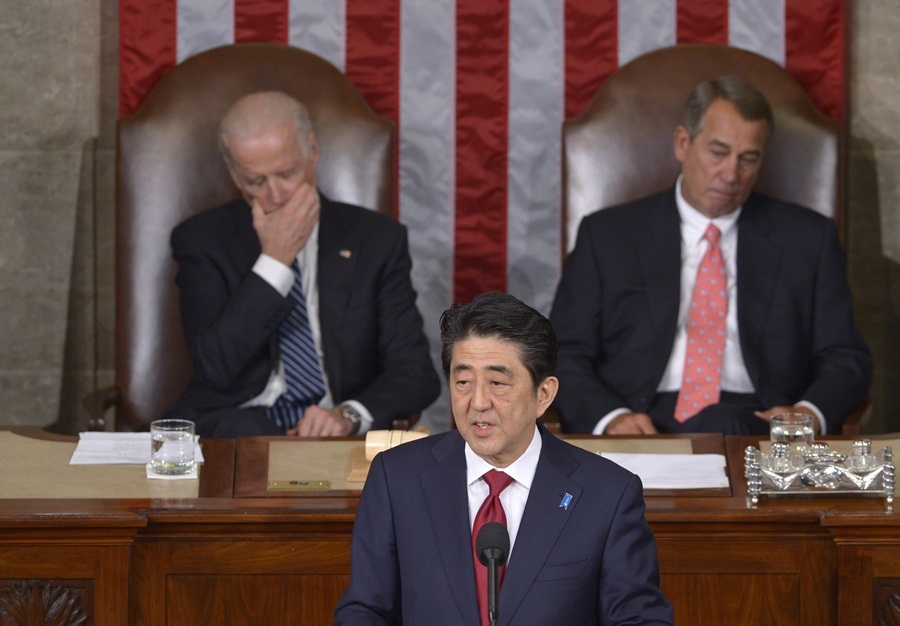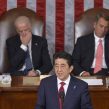
China Takes Stock of U.S.-Japan Alliance as Abe Speaks to Congress
Publication: China Brief Volume: 15 Issue: 9
By:

As Japanese Prime Minister Shinzo Abe visits the United States on April 26-May 3, all eyes in China are watching how Abe speaks about ongoing historical memory issues and how he is strengthening the U.S.-Japan alliance. By revising the defense guidelines on April 27 and speaking in front of a joint session of Congress on April 29—the first time for a Japanese leader—Abe made arguably the most high-profile visit ever by a Japanese prime minister to the United States.
Providing the official Chinese reaction to Abe’s speech, Ministry of Foreign Affairs (MFA) Spokesman Hong Lei said “The Chinese side repeatedly urges the Japanese government and leadership to take a responsible attitude towards history, and act in accordance with the Murayama Statement and other statements and commitment made by previous governments on facing squarely and reflecting upon the history of aggression. This is the only way for Japan to genuinely win the trust of the world and develop friendly relationship for the future with its Asian neighbors” (MFA, April 30).
Abe’s decision to not explicitly apologize or repeat the Kono and Murayama statements, which he was evidently unwilling to do for personal or domestic political considerations, did not satisfy China or South Korea. His decision allows China to continue playing the history card throughout 2015, the 70th anniversary of the end of WWII and Japan’s defeat. Beijing will also very likely use this as further leverage to justify criticism of Japan’s security policy as well as complicate Japan’s relations with South Korea and to a lesser extent the rest of Asia.
The most important Chinese media response came from the People’s Daily, which published an article entitled, “International Community Urges Abe Government to Walk the Road of Peaceful Development” (People’ Daily, April 30). People’s Daily said Abe’s attitude was “ambiguous” and he never apologized for Japan’s use of comfort women during WWII, and that his answer to a reporter’s question on the issue the day before had “concerned people.” As expected, the article focused first and foremost on the issue of Abe’s historical memory but, notably, there was little direct editorial commentary on his speech. Instead, the article cited a wide range of U.S., South Korean and Japanese critics of his speech, as the paper chose to tailor its interviews to more naturally follow the Party line on the issue. The paper quoted many organizations often ignored by the U.S. mainstream press, including Act Now to Stop War and End Racism (ANSWER), the American Defenders of Bataan and Corregidor Memorial Society, the Flying Tiger Historical Organization (with projects apparently funded and tied to the Chinese government) and the Washington Coalition for Comfort Women Issues. The article also discussed protests in Washington, DC and Tokyo against the speech, and the recent letter by 25 congressmen to Abe as well as a letter from former Congressman David Wu (Yonhap, April 24; Xinhua, April 29).
The Chinese media also carried reaction in Japan and the two Koreas. Xinhua wrote that “Japan’s main opposition party on April 30 thoroughly criticized and censured” Abe’s speech (Xinhua, April 30). Global Times said that North and South Korea “demonstrated rare political unity and both condemned Abe’s refusal to apologize” (Global Times, April 30; Channel News Agency, April 30). Xinhua also cited critical remarks by two U.S. congressmen, Mike Honda and Judy Chu (Xinhua, April 30).
The revised U.S.-Japan defense guidelines were also a key focus. People’s Daily said the guidelines will allow Japan to “play a more offensive role” around the world, and the U.S.-Japan alliance has now expanded from Japan’s periphery to the world. MFA Spokesman Hong Lei said, “The US-Japan alliance is a bilateral arrangement forged during the Cold War. The US and Japan shoulder the responsibility of ensuring that a third party’s interests will not be damaged and peace and stability of the Asia-Pacific not be undermined by their alliance” (MFA, April 30). People’s Daily said the revisions “expand the scope of Japan’s military activities abroad and follow in the footsteps of the United States,” which ignores a chorus of protests (People’ Daily, April 30). Guangming Daily listed four new features of the guidelines: first, they expand military cooperation to the entire world and make cooperation from peacetime to conflict “seamless”; second, they included joint island defense, extending from the East to South China Seas; third, cooperation was expanded to space and cyber; and fourth, in the event of conflict, Japan can now not only provide support to the U.S. military, but also assistance (Guangming Daily, March 29).
Former People’s Liberation Army (PLA) Navy officer turned commentator Song Shaojun said that the most important change was the emphasis on “seamless” and “global coverage,” as the alliance was transitioning from “people and platforms” to “people and people” cooperation (People’s Daily Online, April 29). Du Wenlong, a senior researcher at the PLA Academy of Military Science, said that the revisions now allow an “even deeper level of joint operations” between the United State and Japan (People’s Daily Online, April 29). China Institute of International Studies analyst Su Xiaohui noted that the revisions for the first time included space and cyber (People’s Daily Overseas Edition, March 29). She continued with an implicit critique of the U.S.-Japan alliance, writing “in traditional international relations, this type of old model is already not suitable for the new historical conditions. In today’s world, we must build a new model of international relations.”
Yet Chinese commentators do see some weaknesses in the alliance. PLA Naval Research Institute researcher Cao Weidong said the guidelines show “Japan’s dream of forcing the United States to help it seize the Diaoyu Islands is likely to be unfulfilled,” adding that the United States is “extremely clear” on the Islands’ history and there is a “large gap” between Japan’s thoughts and U.S. actions (People’s Daily Online, April 26). The lack of progress on the Trans-Pacific Partnership also remains a weakness from China’s perspective (Xinhua, April 30). While the Chinese media did not expect the United States and Japan to conclude TPP negotiations during Abe’s visit, the decision by many U.S. European allies to join China’s Asian Infrastructure Investment Bank (AIIB) earlier this year left Chinese commentators to conclude there was added pressure on a successful TPP deal, yet expressed doubt and were “not optimistic for the future” of negotiations (Shenzhen TV, April 22).
While the first wave of Chinese commentary mainly focused on Abe’s lack of “apology,” another central focus was on how Abe’s visit was directed toward China. Xinhua cited several analysts to say that “at the same time Abe was downplaying the history of invasion, in his speech he played the ‘sentiment’ and ‘interest’ cards, and strengthened and developed the U.S.-Japan alliance. Although China was never clearly pointed out in the speech, reading between the lines it was targeted at China” (Xinhua, May 1). Deeper security cooperation and an eventual TPP agreement will strengthen the overall U.S.-Japan alliance and allow it to better adjust to a rising China, but a key question will be how the partnership can find ways to work with Beijing on enough issues to avoid a resurgent “Cold War” environment in East Asia in which the U.S.-Japan relationship would be aligned against China.





